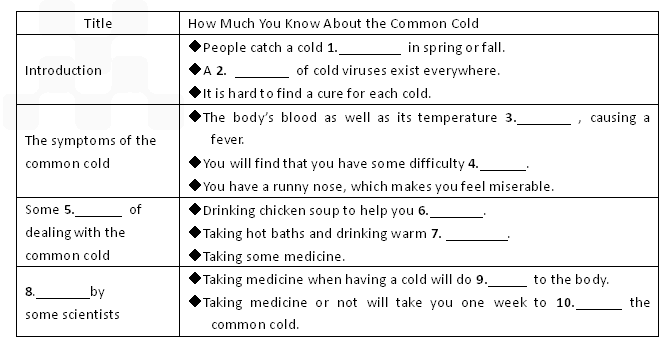
科目: 來源:同步題 題型:閱讀理解
查看答案和解析>>
科目: 來源:四川省月考題 題型:閱讀理解

查看答案和解析>>
科目: 來源:廣東省同步題 題型:填空題
查看答案和解析>>
科目: 來源:廣東省同步題 題型:閱讀理解
 o be more hygienic
o be more hygienic ed that with no reminders, 32 percent of men and 64 percent of women used soap.
ed that with no reminders, 32 percent of men and 64 percent of women used soap.查看答案和解析>>
科目: 來源:山東省期中題 題型:閱讀理解
查看答案和解析>>
科目: 來源:同步題 題型:閱讀理解
查看答案和解析>>
科目: 來源:同步題 題型:閱讀理解

查看答案和解析>>
科目: 來源:廣西壯族自治區(qū)月考題 題型:閱讀理解
查看答案和解析>>
科目: 來源:安徽省月考題 題型:閱讀理解
| 閱讀理解。 | |
| Jim suffered heart problems. In conversation he expressed little joy and it seemed that his life was drawing to a close. When his heart problems led to operation, Jim went through it successfully, and a full recovery was expected. Within days, however, his heart was not beating properly. Jim was rushed back to operation, but nothing was found to explain the cause of his illness. He died on the operating table on the day before his 48th birthday. Dr. Bruce Smoller, a psychologist, had had many conversations with him, and the more he learned, the stranger he realized Jim's case was. When Jim was a child, his father, a teacher, suffered a heart attack and stayed home to recover. One morning Jim asked his father to look over his homework, promising to come home from school at noon to pick it up. His father agreed, but when Jim returned his father had died. Jim's father was 48. "I think all his life Jim believed he killed his father," Dr. Smoller says. "He felt that if he had not asked him to look at his homework, his father would have lived. Jim had been troubled by the idea. The operation was the trial (判決) he had expected for forty years." Smoller believes that Jim willed himself not to live to the age of 48. Jim's case shows the powerful role that attitude plays in physical health, and that childhood experiences produce far-reaching effect on the health of grown-ups. Although most cases are less direct than Jim's, studies show that childhood events, besides genes, may well cause such midlife diseases as cancer, heart disease and mental illness. | |
| 1. Jim was sent back to operation because ________. | |
| A. his heart didn't work well B. he expected a full recovery C. his life was drawing to a close D. the first one wasn't well performed | |
| 2. What made Dr. Smoller feel strange about Jim's case? | |
| A. Jim died at a young age. B. Jim died on the operating table. C. Both Jim and his father died of the same disease. D. Jim's death is closely connected with his father's. | |
| 3. From Smoller's words, we can infer that ______. | |
| A. Jim's father cared little about his study B. Smoller agreed that Jim did kill his father C. Jim thought he would be punished some day D. Smoller believed Jim wouldn't live to the age of 48 | |
| 4. Which of the following could have strong effect on one's physical health according to the text? | |
| A. a, b, d B. a, b, e C. a, c, e D. b, c, d
|
查看答案和解析>>
科目: 來源:山東省期末題 題型:閱讀理解
查看答案和解析>>
湖北省互聯(lián)網(wǎng)違法和不良信息舉報平臺 | 網(wǎng)上有害信息舉報專區(qū) | 電信詐騙舉報專區(qū) | 涉歷史虛無主義有害信息舉報專區(qū) | 涉企侵權(quán)舉報專區(qū)
違法和不良信息舉報電話:027-86699610 舉報郵箱:58377363@163.com